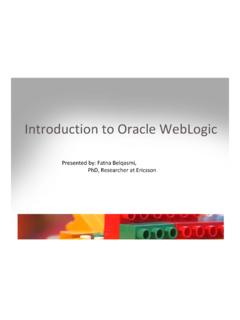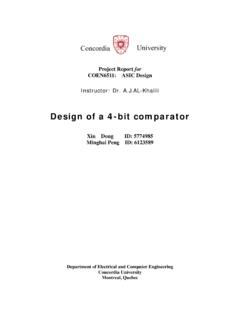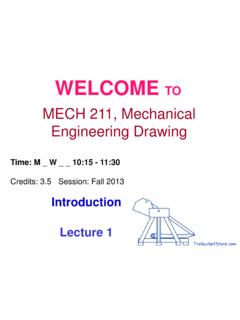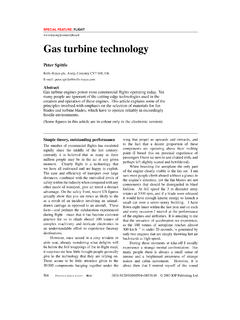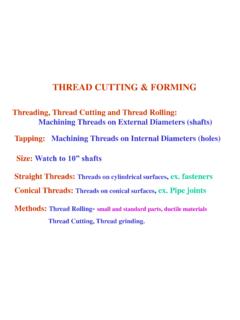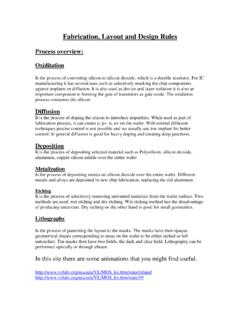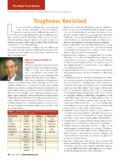Transcription of lecture 10 fracture students-2018.ppt - Concordia University
1 Impact Testing Charpy and Izod tests measure impact energy or notch toughness Outline Charpy V- notch (CVN) most common Before fracture mechanics - impact testing was used to measure impact Impact Testing behaviour and likelihood of brittle fracture . Developed to detect the Charpy Test onset of brittle failure in ductile materials steel ships, bridges etc. Ductile to Brittle Transition Temperature - Still used in quality control and Standards (ship plate etc). Metallurgical Factors Affecting TT Three main factors were producing these fractures in service: Fatigue Triaxial stress state (at notches, cracks etc). Fatigue Testing Low temperatures Types of Fatigue High strain or loading rates Impact testing is used for: checking quality tendency for brittle failure temperature dependence. Dr. M. Medraj Mech. Eng.
2 Dept. Concordia University MSE 521 lecture 11/1 Dr. M. Medraj Mech. Eng. Dept. Concordia University MSE 521 lecture 11/2. Charpy Test Ductile to Brittle Transition in Steel Use standard sized bar specimens Primary function of Charpy test with a central notch At high temperature, CVN for steel Weighted pendulum released from a is relatively high but drops with Impact height, h decrease in temperature Energy Transition Ductile fracture Impacts the specimen behind the notch (stress concentration) At low temperature steel can be brittle fracture of specimen occurs and energy is absorbed The sudden drop in impact energy The pendulum travels to point, h , is the transition Brittle fracture where h < h (DBT). Obtain the amount of absorbed energy Steels should always be used above Temperature from scale their DBT.
3 And .. test Polymers also experience DBT. method Aluminum and copper alloys show Al and Cu have FCC structure . Dr. M. Medraj Mech. Eng. Dept. Concordia University MSE 521 lecture 11/3 Dr. M. Medraj Mech. Eng. Dept. Concordia University MSE 521 lecture 11/4. Ductile to Brittle Transition Behavior Ductile to Brittle Transition Behavior Notch Actual DBT is . to Like tensile specimen, the fractured define, instead minimum surface of an impact specimen also Fibrous zone a requirement of CVN = 20J contains fibrous, radial (granular and ( ) is used shiny zone) and shear lip zones. Radial zone a DBT changes with carbon Fibrous zones occur during the process of crack propagation in materials. content in steel Shear lip zone The proportions of fibrous zone, radial Steels: carbon A sketch of the appearance of fractured zone and shear lip zone vary with temp.
4 Surface of impact specimen after Charpy test Can use fracture surface resulting in different test results. appearance to estimate the DBT When temp. drops to a certain value, the area of the fibrous zone .. and the area of granular zone . sharply. The fracture behavior of Fibrous, grey, the material transforms from ductile to brittle. Brittle, shiny, faceted, bright, dull, possibly DBT temp is usually determined as the area of crystallization zone accounts flat overall, no ridged. Sides for 50% of the whole fractured surface ( as the temp. at which the failure surface or little may be pulled is 50% shiny), and it is denoted by FATT50 ( fracture Appearance Transition deformation in. Hinged. Temp.). Figure 6-11 (Hertzberg). Dr. M. Medraj Mech. Eng. Dept. Concordia University MSE 521 lecture 11/5 Dr. M. Medraj Mech.
5 Eng. Dept. Concordia University MSE 521 lecture 11/6. Selecting Transition Temperature Charpy Test T1: Conservative, above T1. fracture is 100% fibrous. fracture An instrumented Charpy test Transition Plastic (FTP) - very allows determination of energy demanding. required to crack and also energy to .. crack rather T2: 50% cleavage - 50% ductile than just total energy for fracture . fracture Appearance Trans. Temp. (FATT). T3: Average of upper and lower Figure 14-4 (Dieter) Load-time history for an instrumented Charpy test. shelf values. (often approx = T2). Austenitic stainless steels, T4: Arbitrary value of energy copper, most HCP metals absorbed, (CVN) 20 J (15 ) Figure 14-6. Various criteria of transition- temperature obtained from Charpy tests low - medium carbon steels for low strength ship steel. Ductility Transition Temp.
6 The lower this temperature, the High strength steels, T5: 100% cleavage fracture . Nil greater the fracture toughness aluminum, titanium Ductility Temperature (NDT). Dr. M. Medraj Mech. Eng. Dept. Concordia University MSE 521 lecture 11/7 Dr. M. Medraj Mech. Eng. Dept. Concordia University MSE 521 lecture 11/8. Metallurgical Factors Affecting TT Metallurgical Factors Affecting TT. For steels: As %C y , TS , H , % El , CVN and TT . - This can be countered by adding Rolled and forged Manganese - Mn : C should be 3:1 products may have varying Phosphorous increases TT , impact behaviour due to Oxygen in steel .. TT : grain orientation. - semi-killed (add Si) and Note that the difference is - fully-killed (add Si +Al) to not as large at lower remove oxygen temperatures. Remember also: as grain size toughness .. and TT.
7 Niobium and vanadium added to keep grain size small. Figure 14-8 (Deiter) Effect of specimen orientation on Charpy transition-temperature curves. Dr. M. Medraj Mech. Eng. Dept. Concordia University MSE 521 lecture 11/9 Dr. M. Medraj Mech. Eng. Dept. Concordia University MSE 521 lecture 11/10. Fatigue Cyclic Stresses Occurs under dynamic or fluctuating stresses Applied stress: Examples: bridges, automobiles, aircraft axial (compression-tension). and machine components flexural (bending). Failure can occur at stress than under static loading torsional (twisting). Accumulated damage (cracking) occurs Reversed stress cycle is where the over a long period of time catastrophic failure sinusoidal stress is of equal amplitude about a mean of zero 90% of metal failures due to mechanical causes occur in fatigue! max is tensile and min is Also occurs in ceramics, polymers and Fatigue consists of two stages: compressive composites - Crack Initiation Repeated stress occurs when max and Appears as brittle-like failure even in min are about = 0.
8 Ductile materials - Crack Propagation Random stress often occurs in Usually breaks without warning; no or very little, observable plastic deformation engineering and is less easy to quantify (some micro-deformation). Dr. M. Medraj Mech. Eng. Dept. Concordia University MSE 521 lecture 11/11 Dr. M. Medraj Mech. Eng. Dept. Concordia University MSE 521 lecture 11/12. Cyclic Stresses Fatigue Testing and S-N Curves Mean stress, m is defined as: max min . m 2. Range of stresses ( r) is the difference between max and min: r max min Laboratory simulation using rotating beam test. Stress amplitude, a: It creates a reverse cycle bending with rotation (compression/tension).. a max min . r Apply a stress of max ~ 2/3 TS. 2 2. Measure number of cycles (N) to failure Ratio of max. and min. stress is the stress ratio, R: Repeat using progressively lower max (S).
9 Min R Plot S vs. log N S-N curve max Dr. M. Medraj Mech. Eng. Dept. Concordia University MSE 521 lecture 11/13 Dr. M. Medraj Mech. Eng. Dept. Concordia University MSE 521 lecture 11/14. Fatigue Testing and S-N Curves Statistical Nature of Fatigue The data on S-N curves are Two types of S-N curve scattered due to material variability and test 1. Fatigue (endurance) limit for ferrous parameters are difficult to and titanium alloys control FL = - TS (typically) Fatigue strengths are usually average values 2. No fatigue limit with . Probability of failure (P). alloys (Al, Mg and Cu) defined, at 215 MPa 1%. of samples fail at 106 cycles Need to define a fatigue strength at a specified number of cycles (107). Since, this type of curves shows of fatigue Fatigue life (Nf) is the number of failure at certain stress level, it is more accurate than cycles at a specified stress level (S1).
10 Average value as is normally shown. Dr. M. Medraj Mech. Eng. Dept. Concordia University MSE 521 lecture 11/15 Dr. M. Medraj Mech. Eng. Dept. Concordia University MSE 521 lecture 11/16. Types of Fatigue Low-Cycle Fatigue Low cycle fatigue high loads . Nf (104-105 cycles). high stress environment with high design stress and small safety factor, This type of cycling is more likely in nuclear pressure-vessels, steam DS ys turbines, and similar components where repeated stresses are created by thermal fluctuations. scheduled inspection and maintenance of parts (aircraft) if material is constrained and then heated, thermal stresses are most common cause of fatigue .. generated; if it is not constrained we have cyclic thermal strains ( cracking and failure heating and cooling of vessels). High cycle fatigue - Fatigue results from cyclic.
